In just two weeks, Gardenista: The Low-Impact Garden lands in bookstores! We are so appreciative of all the interest the book has already generated. As a thank-you, our publisher is offering a 20-percent discount when you pre-order our book from their site (use code: GARDENISTA20) before October 14.
And if you need further enticement, here’s another sneak peek from the book: a tour of an inspired residential garden in Australia that takes its cues from the coastal national park right next door.
Fiona Brockhoff grew to love the Mornington Peninsula’s wild ocean landscape as a child on vacation. When the renowned landscape designer built her family home here, the style was a nod to 1950s beach shacks—powered by solar panels and rainwater. Her garden is rooted in ecological resilience.
Fiona’s love of native plants stems from long acquaintance, aided by her love of bush walking (or hiking) and camping. The house, named Karkalla after an indigenous coastal plant, and which she shares with her partner and extended family, sits on a strip of land that has the ocean on one side and Port Phillip Bay on the other. “It’s quite a harsh environment—it’s very windy and the soil is sandy,” explains Fiona. “The decisions we made were not just about the layout of the garden and the hard landscape elements. A lot of the plants that I chose were those I’d seen when I’d been walking in the Mornington Peninsula National Park, adjacent to our property.”
The provenance of materials is as local as the plants: “The gravel comes from a nearby quarry, and a lot of the timbers are from a jetty that was renovated when we were building the garden.” Walls of regional limestone anchor the house and garden and are the continuing work of stonemason David Swann, Fiona’s partner, whom she met on the build.
Fiona focuses on “appropriate planting” rather than lecturing people on the rights and wrongs of natives versus non-natives. When a client asks for bamboo and miniature maples to go in a Japanese-style garden, she asks them to go back a step and think about what it is about a Japanese garden that attracts them. Is it the simplicity and the restricted number of plants and elements in that kind of garden? If so, she suggests creating that feeling using local, indigenous plants.
City people on the Mornington Peninsula can bring with them a Melbourne mentality, thinking that constant vigilance is required in watering and general fussing over plants. Fiona tells clients that unless they are growing vegetables, this is not necessary. “It’s more about allowing those plants to be themselves. They don’t require a lot of maintenance because they’re mainly indigenous, or they’re a good ecological fit. Yes, there’s some pruning, and the gravel needs a bit of raking, but on the whole, it’s about working with nature.”
Photography by Caitlin Atkinson.
Above: Sea box (Alyxia buxifolia, foreground) is found in native coastal scrub, but Fiona shapes it like ordinary boxwood. Behind the table is a clipped Melaleuca lanceolata, which in the wild would grow into a large tree. Says Fiona: “We’ve pruned boxwood, roses, and lavender. Why weren’t we pruning Australian plants?” The main barrier is perception, she suggests. “People say to me, ‘Is that really a native garden? But—it’s so beautiful.’”
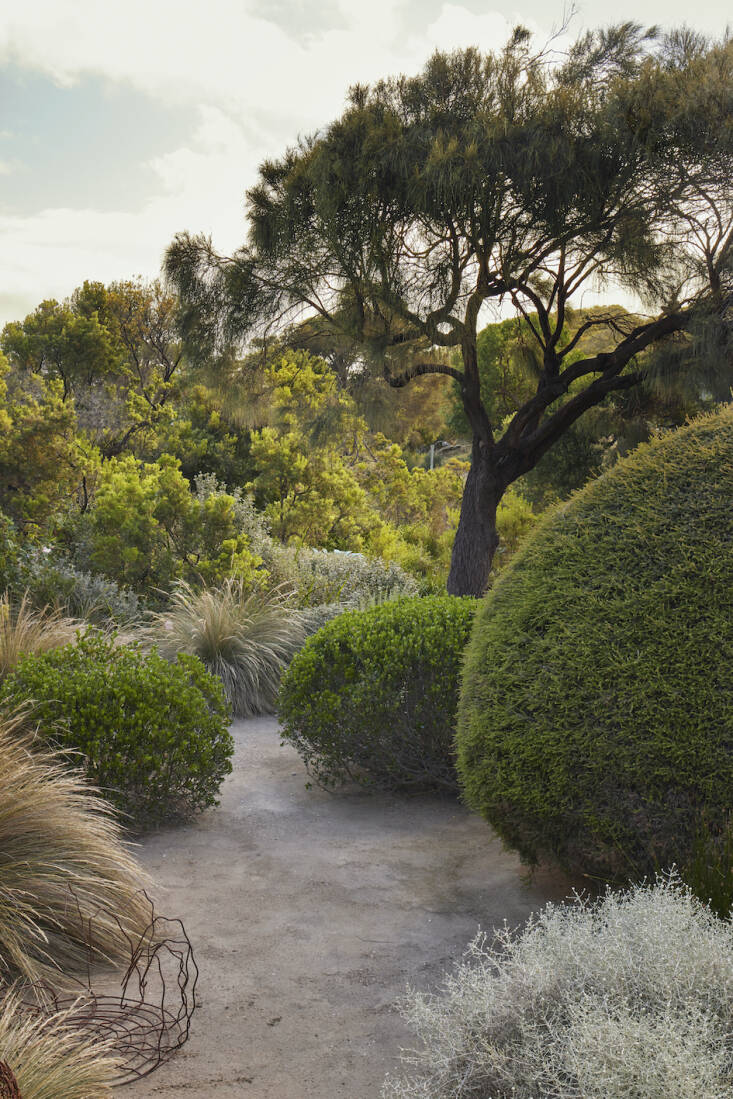 Above: Having spent many years looking at wild plants on the Mornington Peninsula, Fiona wondered how they would respond to being treated like ornamentals. “I’ve got a reputation for torturing plants,” she says. The slightly Japanese aesthetic is aided by local gravel that is fine enough to rake. “You can walk on it with bare feet.”
Above: Having spent many years looking at wild plants on the Mornington Peninsula, Fiona wondered how they would respond to being treated like ornamentals. “I’ve got a reputation for torturing plants,” she says. The slightly Japanese aesthetic is aided by local gravel that is fine enough to rake. “You can walk on it with bare feet.”
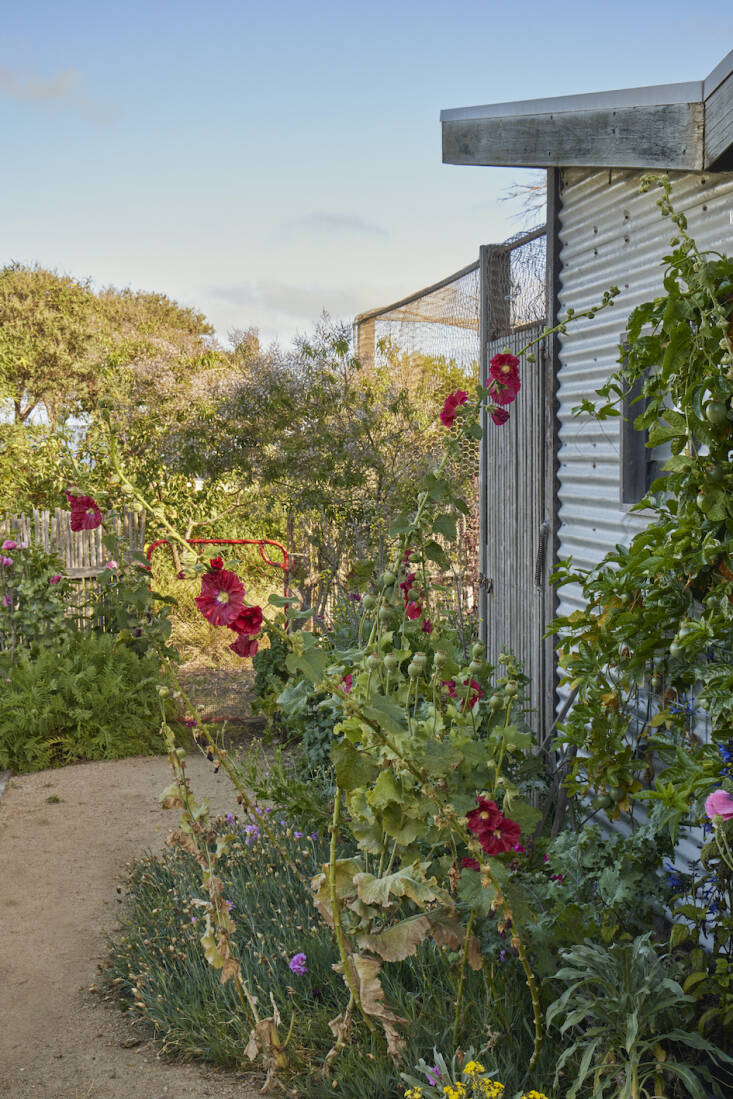 Above: Fiona uses the lower-lying areas of the property for a vegetable and herb garden as well as an orchard. The soil is slightly better here, and chickens contribute nitrogen-rich manure. The corrugated henhouse is beautified with hollyhocks, grown from the seeds of a neighbor in Melbourne.
Above: Fiona uses the lower-lying areas of the property for a vegetable and herb garden as well as an orchard. The soil is slightly better here, and chickens contribute nitrogen-rich manure. The corrugated henhouse is beautified with hollyhocks, grown from the seeds of a neighbor in Melbourne.
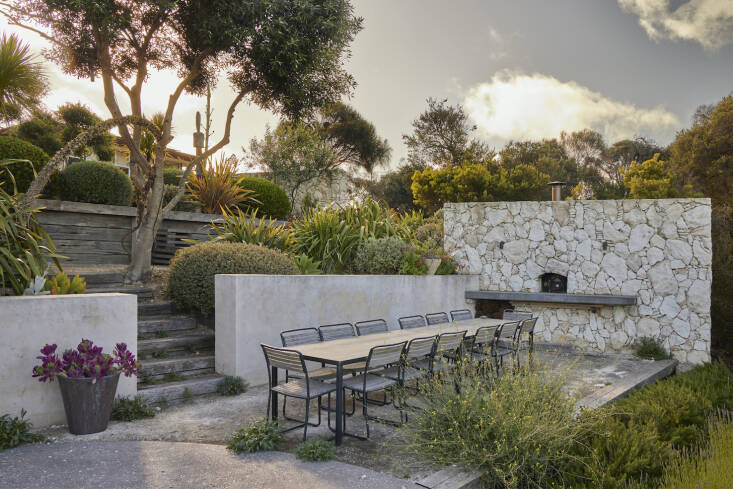 Above: A long table is slotted into the unfolding landscape, the ground laid here with compacted granite rubble. Its permeable surface invites some self-seeding. “That’s a really big wild rocket, which I leave during winter because bees love flowering brassicas. We keep bees, so I’m always thinking about what they might like to eat.”
Above: A long table is slotted into the unfolding landscape, the ground laid here with compacted granite rubble. Its permeable surface invites some self-seeding. “That’s a really big wild rocket, which I leave during winter because bees love flowering brassicas. We keep bees, so I’m always thinking about what they might like to eat.”
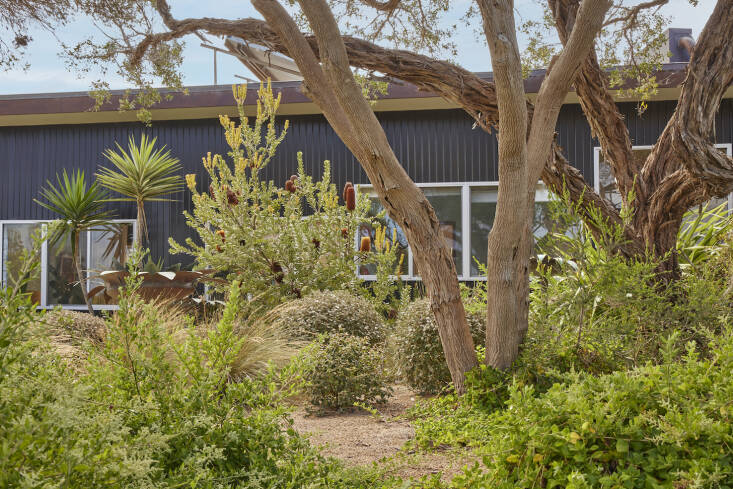 Above: Like a 1950s beach house from the misty past, but surrounded with more interesting planting, the building is a backdrop for yucca by the windows, with red-coned Banksia praemorsa. Coast tea tree (Leptospermum laevigatum), with rough bark, is joined by rounded seaberry saltbush (Rhagodia candolleana).
Above: Like a 1950s beach house from the misty past, but surrounded with more interesting planting, the building is a backdrop for yucca by the windows, with red-coned Banksia praemorsa. Coast tea tree (Leptospermum laevigatum), with rough bark, is joined by rounded seaberry saltbush (Rhagodia candolleana).
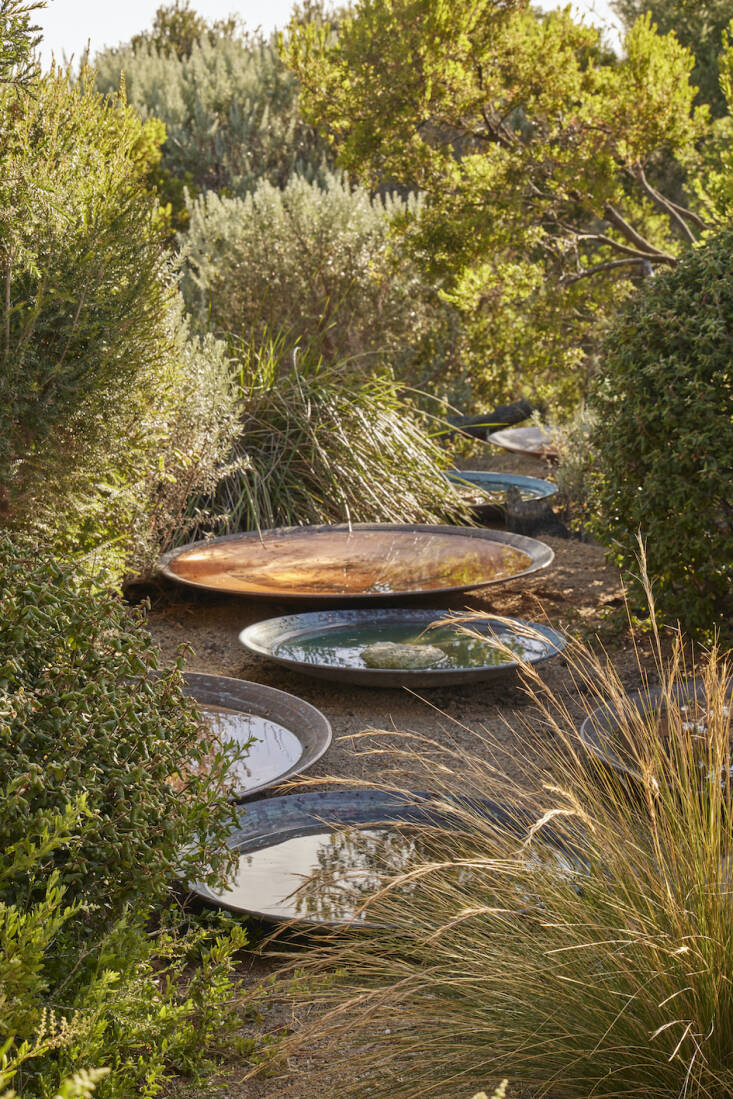 Above: You can never have too many bowls of water, although strictly speaking, this is Fiona’s “aging center” for the bird baths that she designs, which are manufactured by a local metal spinner. They are set out in the sea air to transition from bright copper to verdigris before being sold or given away as gifts. They are also featured in our “Gardenista 50,” 34 pages of covetable garden objects in The Low-Impact Garden.
Above: You can never have too many bowls of water, although strictly speaking, this is Fiona’s “aging center” for the bird baths that she designs, which are manufactured by a local metal spinner. They are set out in the sea air to transition from bright copper to verdigris before being sold or given away as gifts. They are also featured in our “Gardenista 50,” 34 pages of covetable garden objects in The Low-Impact Garden.
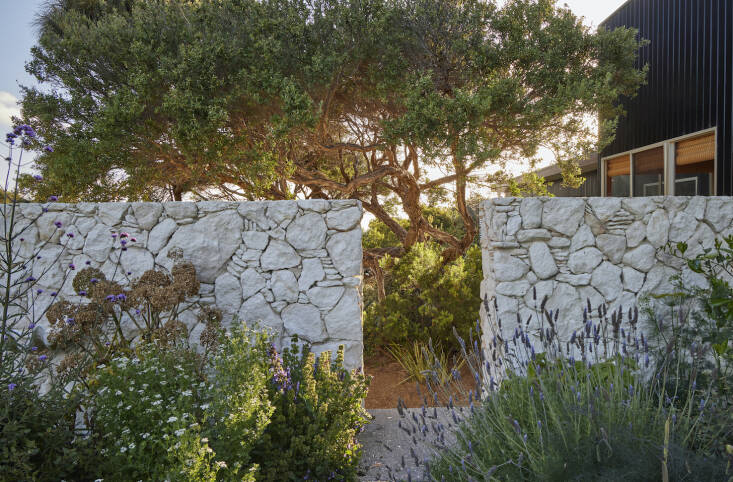 Above: David’s most recent limestone wall separates the ocean side of the garden from a utility area that captures the sun and is designated for herbs and laundry. In permaculture terms, Fiona explains, this would be considered “zone one,” being used frequently. The gap leads to an exposed part of the garden where local indigenous plants are left “to make their own pictures.”
Above: David’s most recent limestone wall separates the ocean side of the garden from a utility area that captures the sun and is designated for herbs and laundry. In permaculture terms, Fiona explains, this would be considered “zone one,” being used frequently. The gap leads to an exposed part of the garden where local indigenous plants are left “to make their own pictures.”
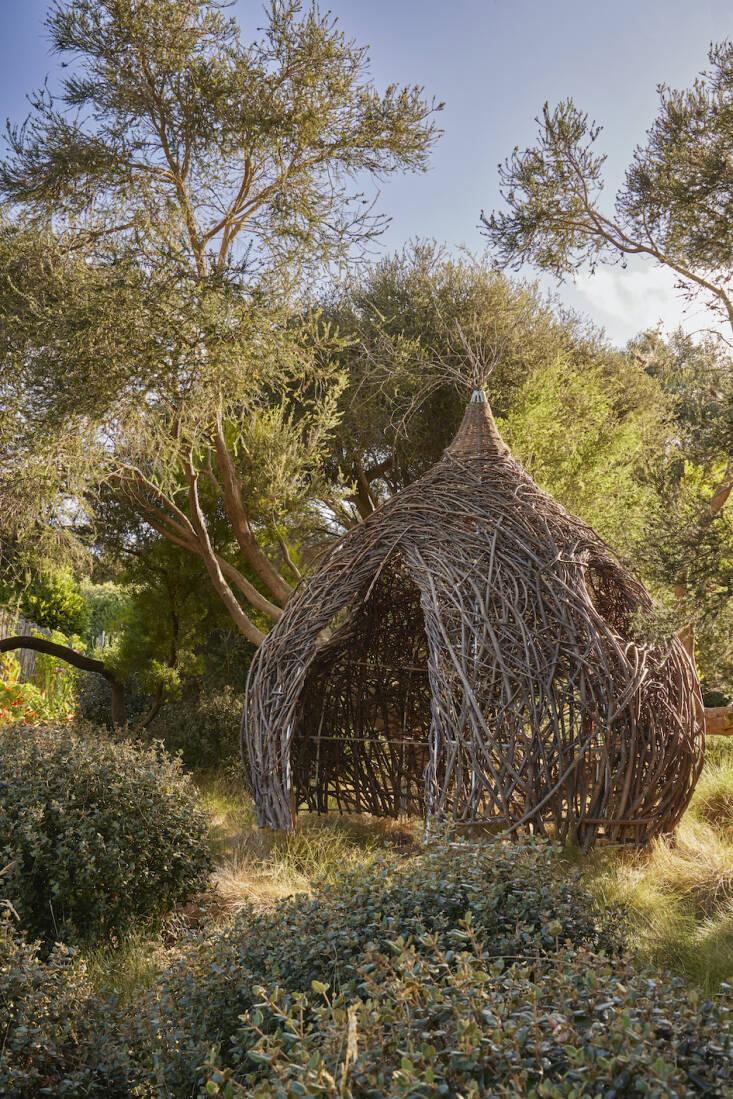 Above: A “cubby house” for Fiona’s great-nieces, built by willow artist Gay Chatfield. It could just as easily be a “meditation hub,” or any number of things. “Gay makes enclosures for animals to sleep in at the zoo. She’s done all these beautiful homes for the lemurs,” says Fiona. (For more on willow structures, see 5 Favorites: Storybook Twig Playhouses for Indoors and Out.)
Above: A “cubby house” for Fiona’s great-nieces, built by willow artist Gay Chatfield. It could just as easily be a “meditation hub,” or any number of things. “Gay makes enclosures for animals to sleep in at the zoo. She’s done all these beautiful homes for the lemurs,” says Fiona. (For more on willow structures, see 5 Favorites: Storybook Twig Playhouses for Indoors and Out.)
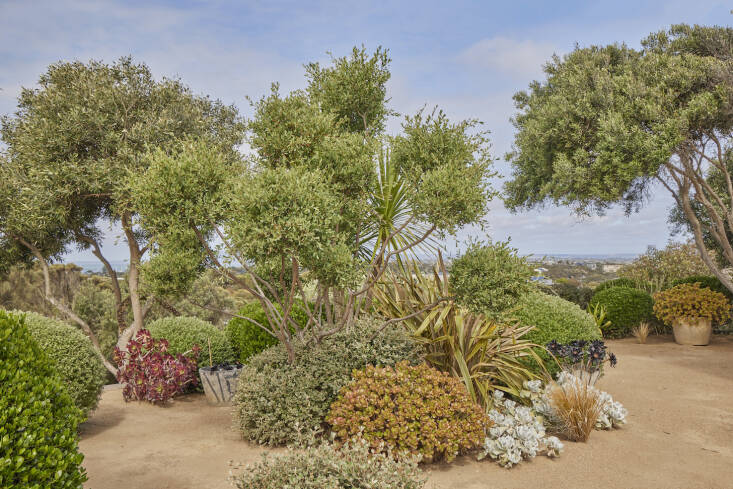 Above: Looking toward Port Philip Bay, rounded small-leaved plants are balanced by mounds of succulents, including several forms of Aeonium arboreum ‘Atropurpureum’ and silvery Cotelydon orbiculata ‘Silver Wave’. New Zealand natives Phormium tenax cultivars and Cordyline australis contrast with their sword-like leaves. Fiona learned about gravel gardening as a student with British modern design guru John Brookes.
Above: Looking toward Port Philip Bay, rounded small-leaved plants are balanced by mounds of succulents, including several forms of Aeonium arboreum ‘Atropurpureum’ and silvery Cotelydon orbiculata ‘Silver Wave’. New Zealand natives Phormium tenax cultivars and Cordyline australis contrast with their sword-like leaves. Fiona learned about gravel gardening as a student with British modern design guru John Brookes.
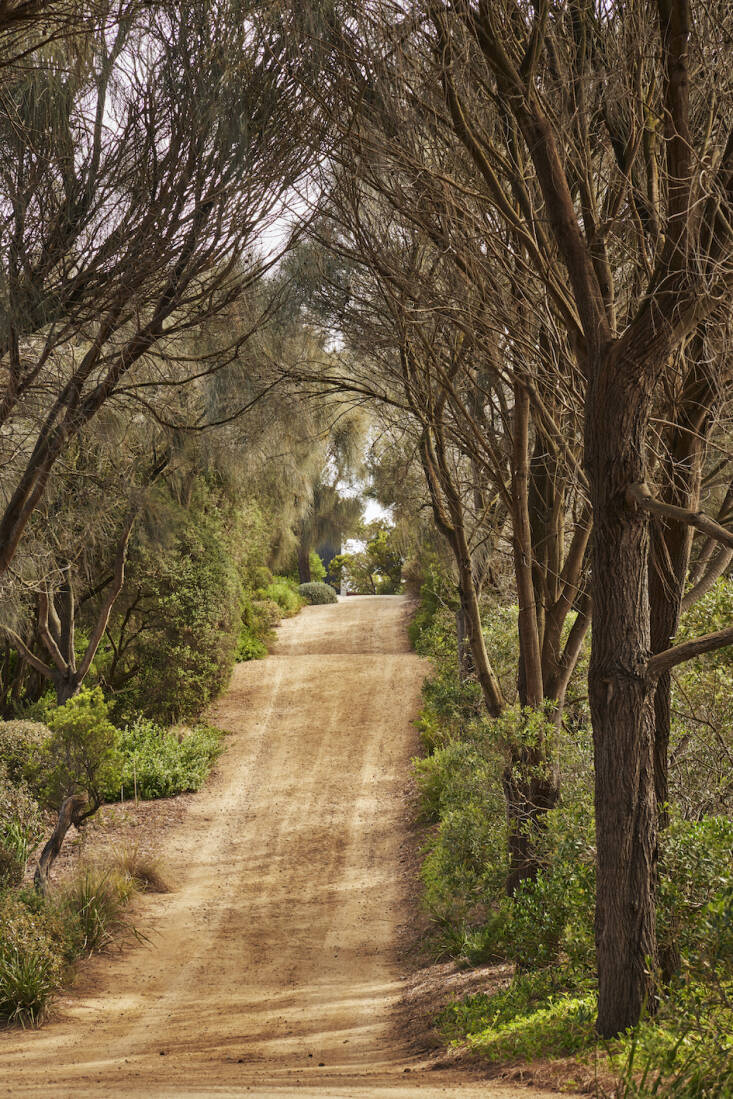 Above: The land around Karkalla is naturally undulating, but this long driveway had been flattened for expedience. “People used to fly up the driveway and arrive in a cloud of dust,” recalls Fiona. David restored the track, in a tunnel of local indigenous Allocasuarina verticillata, into a series of rises and dips that slow vehicles down. Instead of putting your foot on the gas, “the experience of moving over the land is a way of respecting the land.”
Above: The land around Karkalla is naturally undulating, but this long driveway had been flattened for expedience. “People used to fly up the driveway and arrive in a cloud of dust,” recalls Fiona. David restored the track, in a tunnel of local indigenous Allocasuarina verticillata, into a series of rises and dips that slow vehicles down. Instead of putting your foot on the gas, “the experience of moving over the land is a way of respecting the land.”
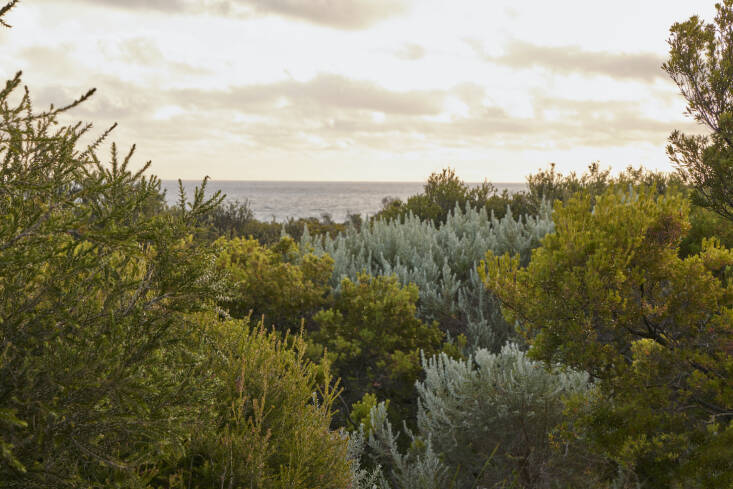 Above: The garden’s boundary is invisible when native trees and shrubs are used. With small leaves to minimize evaporation, silvery Olearia axillaris, coast beard heath (Leucopogon parviflorus), and trees such as black paper bark (Melaleuca lanceolata) and coast tea tree (Leptospermum laevigatum) direct the eye toward the oceat at Bass Strait, just beyond the Mornington Peninsula National Park.
Above: The garden’s boundary is invisible when native trees and shrubs are used. With small leaves to minimize evaporation, silvery Olearia axillaris, coast beard heath (Leucopogon parviflorus), and trees such as black paper bark (Melaleuca lanceolata) and coast tea tree (Leptospermum laevigatum) direct the eye toward the oceat at Bass Strait, just beyond the Mornington Peninsula National Park.
Lessons Learned: See Plants in a Different Way
Fiona’s planting choices were almost entirely influenced by the landscape around her, in the national park near her house. Here are three ideas for landing on the right plant palette.
• Notice how plants paint a picture. “It’s really important to use your eyes when you observe nature, but also when you see other people’s gardens,” says Fiona. “To try to look at that garden analytically, and work out why it is that you’re drawn to it.”
• Be open-minded. Step away from set ideas and look a bit deeper. Says Fiona: “A lot of my consideration when it comes to planting is about foliage color and shape—and also plant habit, rather than, Has it got purple-blue flowers?.”
• Go for full immersion. Hiking is good and camping is even better for learning about plants. When she was thirteen, Fiona spent a whole year living out in nature with her classmates. “I started looking at the bush [trees, brush, and scrub] with completely different eyes.” Fiona is now permanently drawn to spending time in coastal and alpine environments (and not always in Australia), noting the adaptations of plants in surviving harsh conditions, and seeing how they might work in her own garden.
For more on our new book, see:



